本文
Bibliography

Men at Work: Photographic Studies of Modern Men and Machines
The Macmillan Company; New York.
1932,
48pages.
260x208 mm.
1/35
No narration on page 3
Men At Work
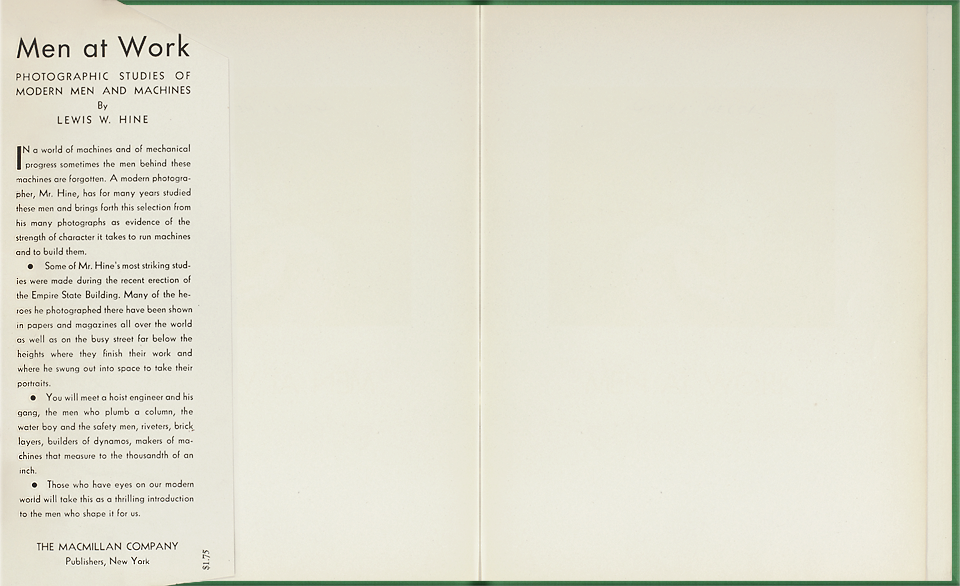
3/35 Push an image to enlarge
No narration on page 4
Men At Work
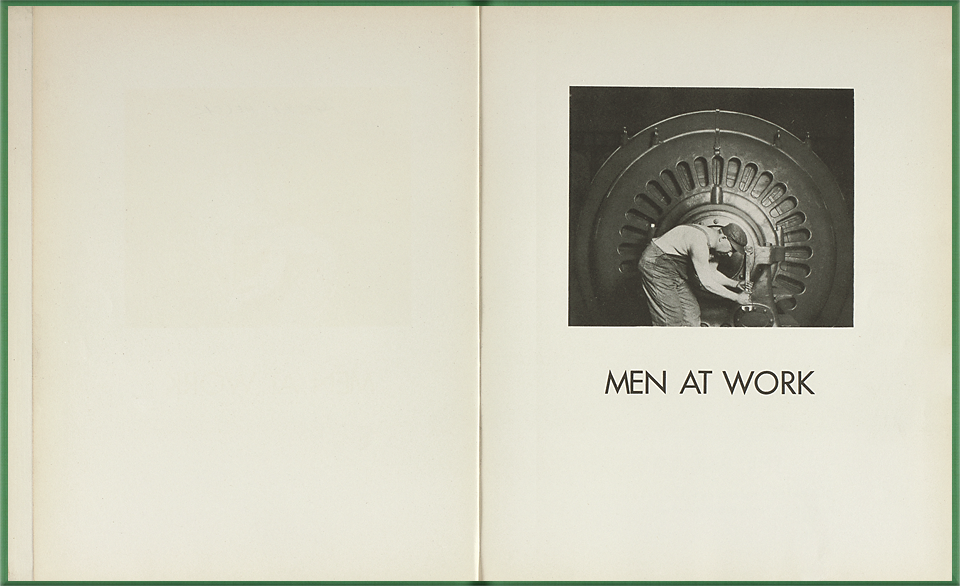
4/35 Push an image to enlarge
Men At Work
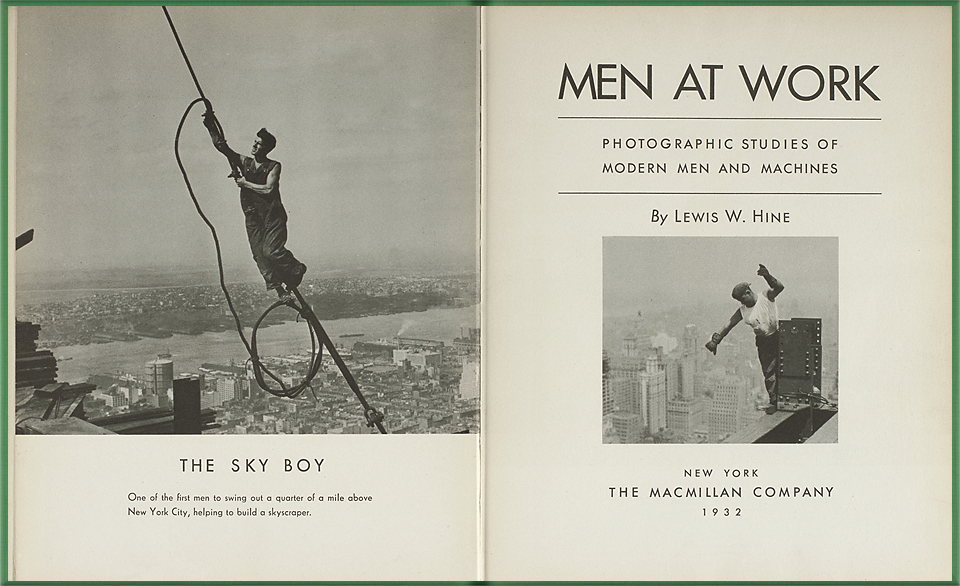
5/35 Push an image to enlarge
(♪) THE SKY BOY. One of the first men to swing out a quarter of a mile above New York City, helping to build a skyscraper.
(♪) MEN AT WORK: PHOTOGRAPHIC STUDIES OF MODERN MEN AND MACHINES. By Lewis W. Hine
(♪) MEN AT WORK: PHOTOGRAPHIC STUDIES OF MODERN MEN AND MACHINES. By Lewis W. Hine
Men At Work
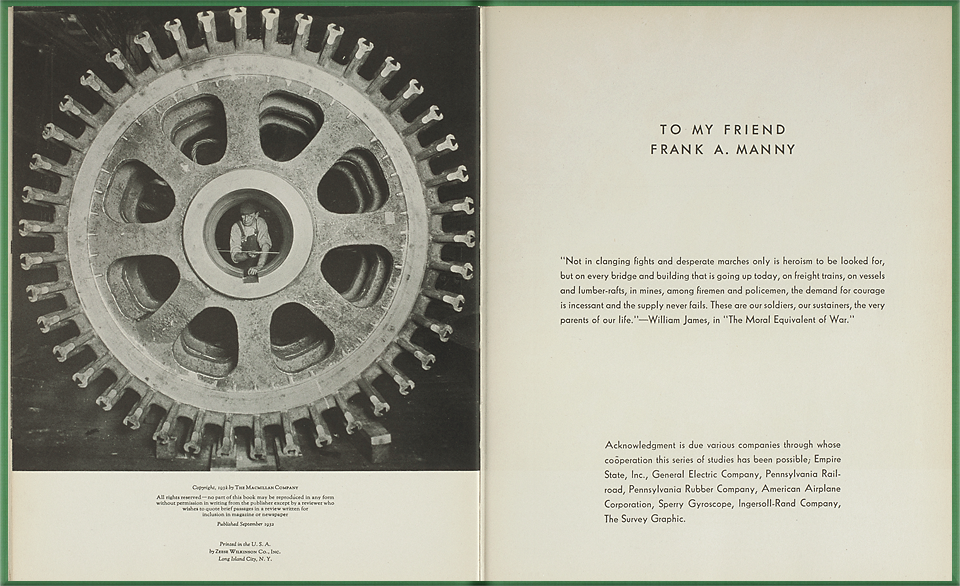
6/35 Push an image to enlarge
(♪) TO MY FRIEND FRANK A. MANNY. “Not in clanging fights and desperate marches only is heroism to be looked for, but on every bridge and building that is going up today, on freight trains, on vessels and lumber-rafts, in mines, among firemen and policemen, the demand for courage is incessant and the supply never fails. These are our soldiers, our sustainers, the very parents of our life.”−William James, in “The Moral Equivalent of War.”
Men At Work
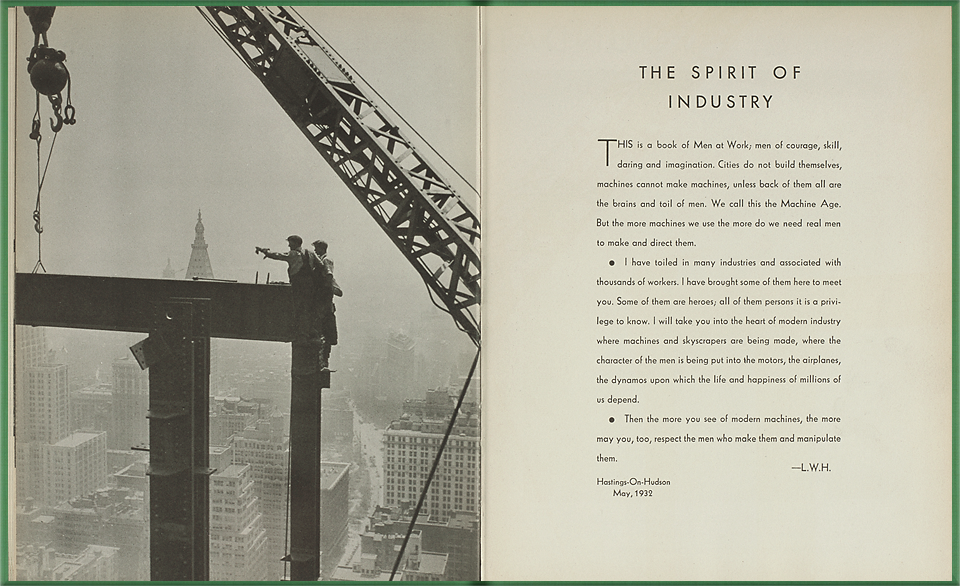
7/35 Push an image to enlarge
(♪) THE SPIRIT OF INDUSTRY. This is a book of Men at Work; men of courage, skill, daring and imagination. Cities do not build themselves, machines cannot make machines, unless back of them all are the brains and toil of men. We call this the Machine Age. But the more machines we use the more do we need real men to make and direct them. I have toiled in many industries and associated with thousands of workers. I have brought some of them here to meet you. Some of them are heroes; all of them persons it is a privilege to know. I will take you into the heart of modern industry where machines and skyscrapers are being made, where the character of the men is being put into the motors, the airplanes, the dynamos upon which the life and happiness of millions of us depend. Then the more you see of modern machines, the more may you, too, respect the men who make them and manipulate them.−Lewis W. Hine. Hastings-On-Hudson. May, 1932
Men At Work
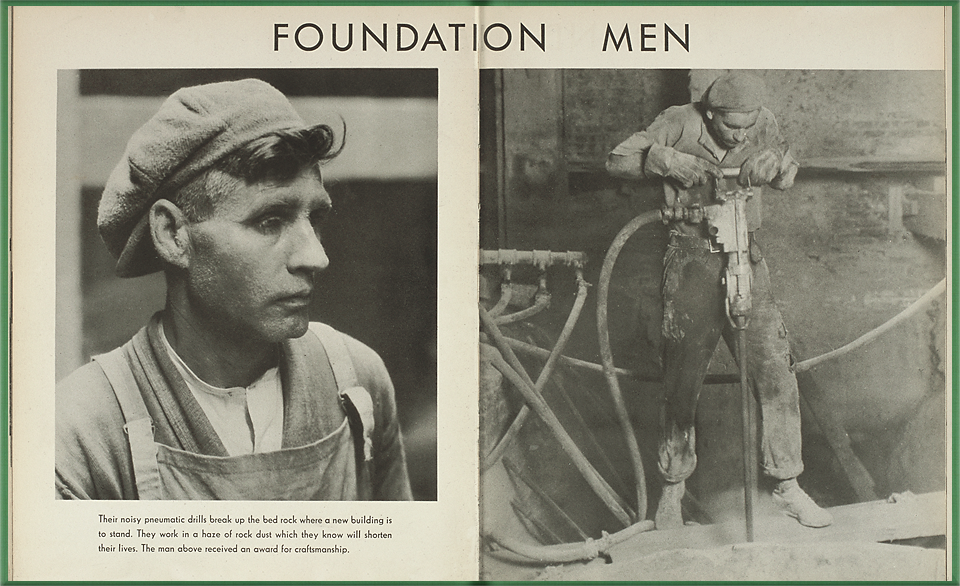
8/35 Push an image to enlarge
(♪) FOUNDATION MEN. Their noisy pneumatic drills break up the bed rock where a new building is to stand. They work in a haze of rock dust which they know will shorten their lives. The man above received an award for craftsmanship.
Men At Work
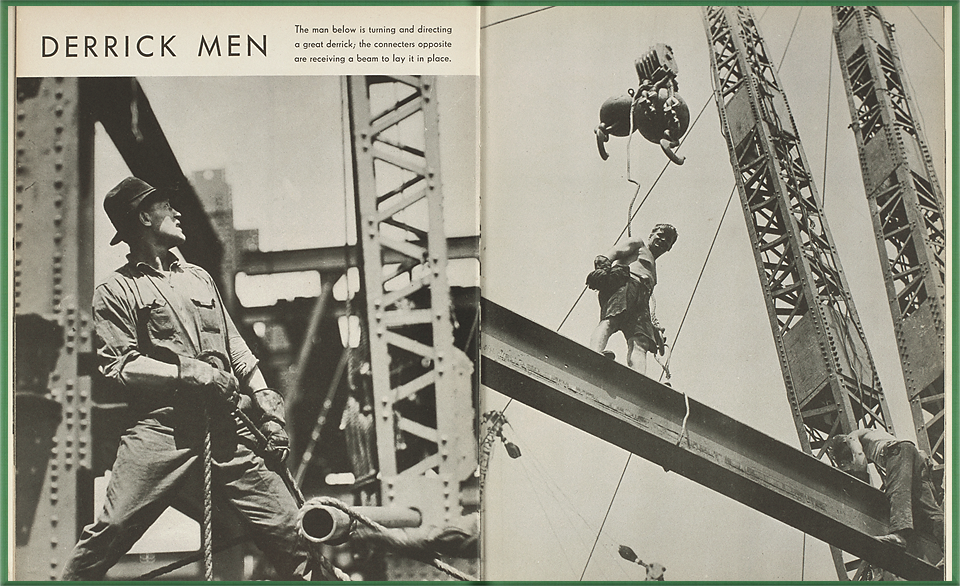
9/35 Push an image to enlarge
(♪) DERRICK MEN. The man below is turning and directing a great derrick; the connecters opposite are receiving a beam to lay it in place.
Men At Work
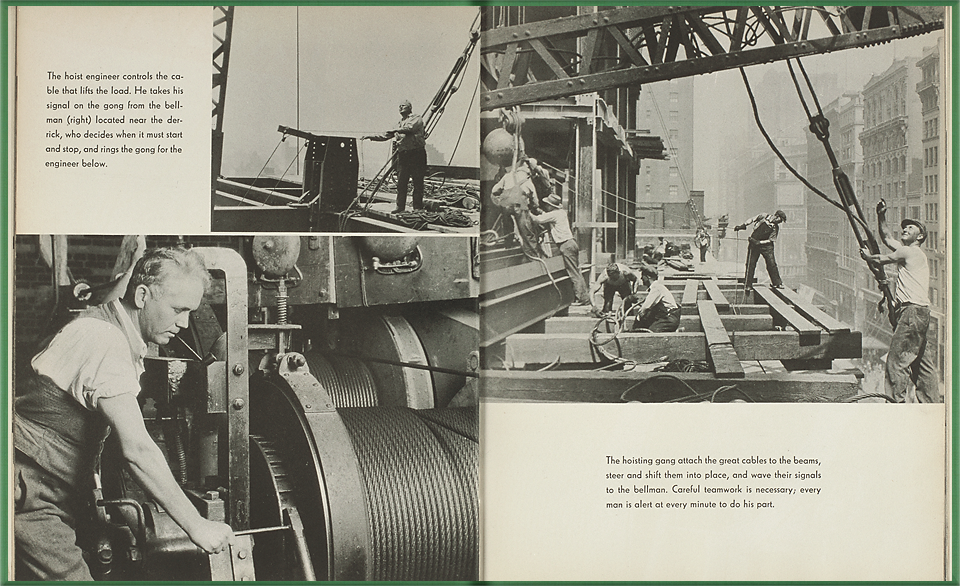
10/35 Push an image to enlarge
(♪) The hoist engineer controls the cable that lifts the load. He takes his signal on the gong from the bellman (right) located near the derrick, who decides when it must start and stop, and rings the gong for the engineer below.
(♪) The hoisting gang attach the great cables to the beams, steer and shift them into place, and wave their signals to the bellman. Careful teamwork is necessary; every man is alert at every minute to do his part.
(♪) The hoisting gang attach the great cables to the beams, steer and shift them into place, and wave their signals to the bellman. Careful teamwork is necessary; every man is alert at every minute to do his part.
Men At Work

11/35 Push an image to enlarge
(♪) As the building pushes skyward the connecters stay aloft and bolt the beams after they have swung into place. Two of them (opposite) are going up to the next height, like spiders spinning a fabric of steel against the sky.
Men At Work

12/35 Push an image to enlarge
(♪) This derrick gang is moving a heavy load of planks while men in the foreground extend the bull-stick of the derrick for greater leverage. Opposite, another connecter goes aloft.
Men At Work

13/35 Push an image to enlarge
(♪) CHECKING UP. The work is checked continually to make the building “true.” A group of engineers, with their surveyors’ instruments, check the vertical lines before it is too late to correct them. As soon as each column has been placed a plumber-up drops his bob and the huge steel column is straightened.
Men At Work

14/35 Push an image to enlarge
(♪) Another check-up is the safety man, who climbs searching every part of the growing structure for a loose board, a neglected wire or tool. He safeguards the workers and the people below in the street. The hoister (opposite) watches with special care as he guides a great load of steel beams.
Men At Work

15/35 Push an image to enlarge
(♪) RIVETING GANG. The riveter drives the bolt home with his pneumatic gun; the bucker-up holds the rivet in place; the catcher picks the red-hot bolt out of the air with his tin scoop, when it is thrown up from the floor below. Standing on a few planks, in high dangerous places, these men need skill, strength, and courage. “Safer up here than it is down below,” is their idea of the job.
Men At Work

16/35 Push an image to enlarge
(♪) The burner, above, is cutting the beam with his acetylene torch. The heater, right, gets the bolts red hot and tosses them to the riveters. The welder, opposite, is working on a great steel pipe in its shaft. Industrial fireworks!
Men At Work

17/35 Push an image to enlarge
(♪) The bolt boy with a bag of bolts begins at eighteen. He hopes some day to be boss of the gang. He will have to take good care of himself, if he is to stay on the job as long as the old bolter above. Young and old, they all say it isn’t really as dangerous as it looks. (Opposite) Riveters working on a tower.
Men At Work

18/35 Push an image to enlarge
(♪) FINISHING UP THE JOB. A derrick man moves up to the next floor; soon the highest derrick will come down and the job will be over. The men opposite are working on the tip of the mooring mast on the Empire State Building. This is the highest point yet reached on a man-made structure, a quarter of a mile up in the clouds.
Men At Work

19/35 Push an image to enlarge
(♪) RAILROAD MEN. This modern Thor swings his hammer in a power house that sends driving force out along a great electric railroad line.
(♪) A railroad builder, at work on a car wheel in one of the great machine shops that turn out the engines of to-day.
(♪) A railroad builder, at work on a car wheel in one of the great machine shops that turn out the engines of to-day.
Men At Work

20/35 Push an image to enlarge
(♪) The track walker on his long patrol, looking for flaws in the miles of tracks; and another mechanic welding a car wheel which will soon roll over them.
(♪) A worker of long experience carefully drills a huge steel plate that will hold a Pullman car together.
(♪) A worker of long experience carefully drills a huge steel plate that will hold a Pullman car together.
Men At Work

21/35 Push an image to enlarge
(♪) “Forty years in the cab, and I’ve never killed anything, human or animal.” Such a record is the pride of this engineer. Opposite is a “cowboy of the yards,” a brakeman who has galloped over America on the tops of many freight cars.
Men At Work

22/35 Push an image to enlarge
(♪) MAKING MACHINES. Grinding and adjusting the plates for a big turbine.
(♪) Boring bolt holes with a power drill, on the chassis of a truck.
(♪) Boring bolt holes with a power drill, on the chassis of a truck.
Men At Work

23/35 Push an image to enlarge
(♪) TIRE MAKERS. At the control wheel of an enormous calender, making automobile tires.
(♪) The foreman checks up, while a skilled workman prepares the fabric for the tires.
(♪) The foreman checks up, while a skilled workman prepares the fabric for the tires.
Men At Work

24/35 Push an image to enlarge
(♪) AIRPLANE MAKERS. One skilled mechanic is at work on the radial motor of an airplane. Another is welding the frame of an airplane; the slightest flaw would mean a smash-up.
Men At Work

25/35 Push an image to enlarge
(♪) SPECIAL SKILL. Man with micrometer, measuring the steel shaft of a large machine; he is trimming it down in a great lathe. His work must be accurate to the thousandth of an inch. Another skilled mechanic (opposite) beveling the gears for a small machine.
Men At Work

26/35 Push an image to enlarge
(♪) COAL MINERS. At the end of their shift, the miners come up on a “man trip” in the empty cars.
(♪) A pair of miners are drilling for a “shot,” in a narrow seam of coal very deep down. Below them, a veteran miner with his lamp lit.
(♪) A pair of miners are drilling for a “shot,” in a narrow seam of coal very deep down. Below them, a veteran miner with his lamp lit.
Men At Work
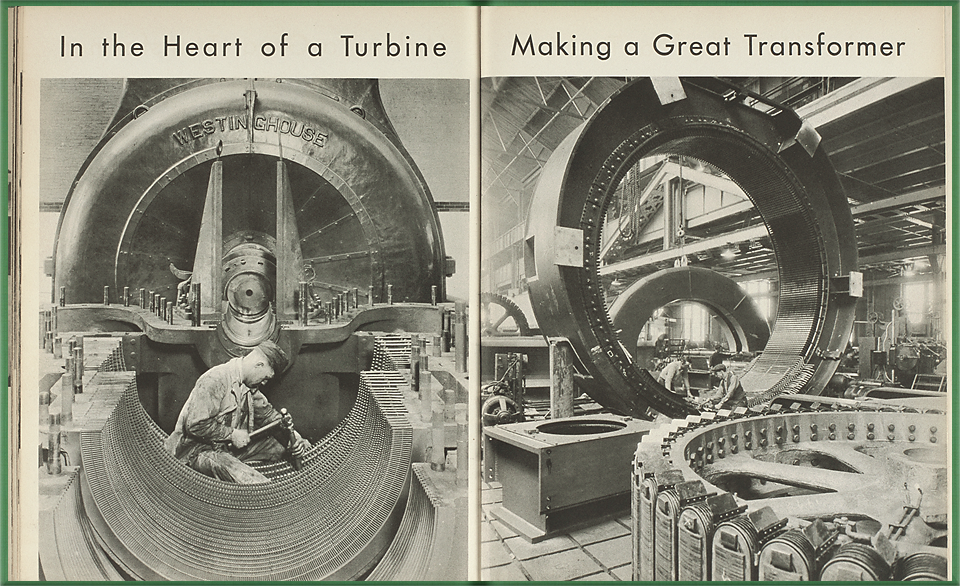
27/35 Push an image to enlarge
(♪) In the Heart of a Turbine
(♪) Making a Great Transformer
(♪) Making a Great Transformer
No narration on page 28
Men At Work

28/35 Push an image to enlarge
No narration on page 29
Men At Work
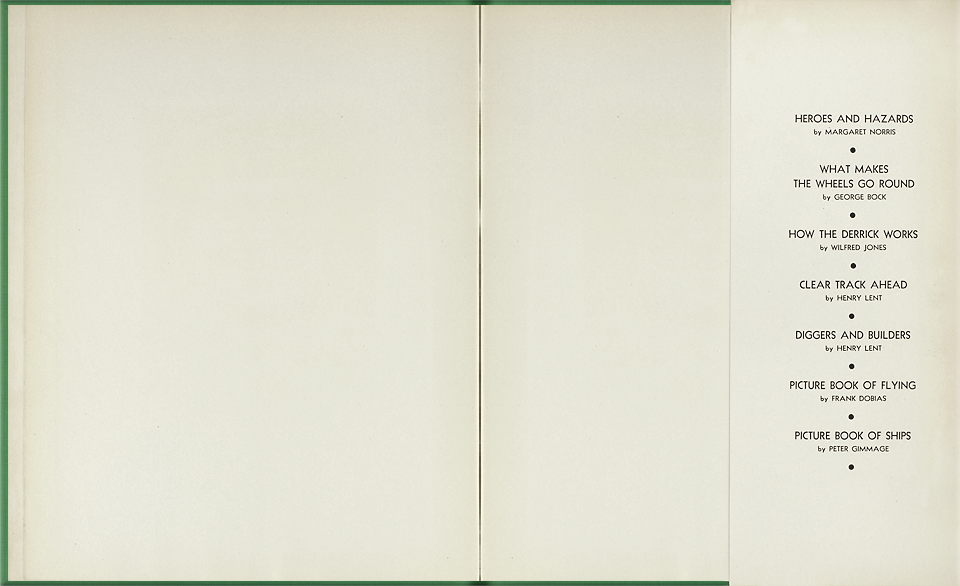
29/35 Push an image to enlarge
No narration on page 30
Men At Work

30/35 Push an image to enlarge
No narration on page 31
About the author 1/4
By Lewis W. Hine (1874–1940)\
1)
This book consists of photographs of the men working on what was then the tallest building in the world, the Empire State Building, first conceived as a dock for Zeppelin and other airships.It was a time when machines and technology were thought to be the harbingers of future happiness. For many, however, the civilization of machines also created the cruel fate of unemployment. The right page of the inside cover shows the famous “Skyboy” photograph, a boy working on a wire 400-meters above ground in New York that became one of Hine’s best-known works among photographs of the men working on the construction of skyscrapers.
31/35
No narration on page 32
About the author 2/4
2)
Hine’s dedication of the book to Frank A. Manny quotes from William James’s The Moral Equivalent of War in praise of the heroism of the men engaged in construction work, and as police and firemen. In his preface to the book under the title, “The Spirit of Industry,” he notes “the more machines we use the more do we need real men to make and direct them” and his photographs take the reader to “the heart of modern industry . . .where the character of the men is being put into the motors, the airplanes, the dynamos upon which the life and happiness of millions of us depend.”
32/35
No narration on page 33
About the author 3/4
3)
Born in 1874 in Oshkosh, Wisconsin, Hine held a degree in sociology from Columbia University in 1907. Using photographs as teaching materials and for research, he had already begun his stories told in photographs for children from around 1908. This work later led to his book, Men at Work.
33/35
No narration on page 34
About the author 4/4
4)
Hine is well known for his photographs of immigrants on Ellis Island, but also for those documenting child labor in factories, coal mines, and late-night newspaper sales, images that contributed to the establishment of laws against child labor. During World War I, he photographed Red Cross refugee centers, depicting the need for relief of displaced persons in Eastern Europe. In the 1920s he made many photographic portraits of factory workers and in the 1930s documented the construction of the Empire State Building. In the latter part of the 1930s he became a freelance photographer. He passed away in poverty at his home in a New York suburb decades before his work would finally win recognition and acclaim.
34/35
Contents
35/35

